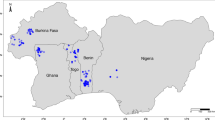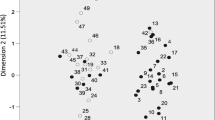Abstract
Genetic variability within and among 19 landraces and cultivars of red clover (Trifolium pratense L.) was investigated by means of amplified fragment length polymorphism (AFLP) analysis in order to assess the potential value of Swiss Mattenklee landraces as genetic resources for plant breeding and the preservation of biodiversity. Populations were classified into three groups according to their origin and agronomic features: Mattenklee landraces (8), Mattenklee cultivars (8) and field clover cultivars (3). Analysis of molecular variance based on 276 polymorphic AFLP markers revealed 80% of total variability to be due to variability within populations while 12% were attributed to variability among groups. Stepwise discriminant analysis identified a subset of 126 AFLP markers which best separated individual plants into the three respective groups. Genetic distances between populations were considerably larger among groups than among populations within the same group, providing further evidence for the genetic distinction between Mattenklee landraces, Mattenklee cultivars and field clover cultivars. AFLP markers identified two landrace clusters, containing three and four populations respectively, which, together with one additional landrace, may sufficiently represent the genetic variability of all eight landraces investigated. The results of this study strongly suggest that Swiss Mattenklee landraces form a genetically distinct group of red clover. The data obtained provide criteria on how to efficiently manage, preserve and exploit Mattenklee germplasm.




Similar content being viewed by others
References
Annicchiarico P, Piano E (1997) Effect of selection under cultivation on morphological traits and yield of ladino white clover landraces. Genet Res Crop Evol 44:405–410
Badoux S, Guyer H, Lehmann J (1967) Red clover trials 1964–66. Mitt Schweiz Landw 15:140–146
Boller B (2000a) History and development of the Swiss "Mattenklee", a persistent form of cultivated red clover. Vierteljahresschr Nat Forsch Ges Zürich 145:143–151
Boller B (2000b) Corvus and Pica: two new red clover cultivars of the persistent "Mattenklee" type. Agrarforschung 7:484–489
Campos-De-Quiroz H, Ortega-Klose F (2001) Genetic variability among elite red clover (Trifolium pratense L.) parents used in Chile as revealed by RAPD markers. Euphytica 122:61–67
Crouch HK, Crouch JH, Madsen S, Vuylsteke DR, Ortiz R (2000) Comparative analysis of phenotypic and genotypic diversity among plantain landraces (Musa spp., AAB group). Theor Appl Genet 101:1056–1065
Excoffier L, Smouse PE, Quattro JM (1992) Analysis of molecular variance inferred from metric distances among DNA haplotypes: application to human mitochondrial DNA restriction data. Genetics 131:479–491
Fahima T, Sun GL, Beharav A, Krugman T, Beiles A, Nevo E (1999) RAPD polymorphism of wild emmer wheat populations, Triticum dicoccoides, in Israel. Theor Appl Genet 98:434–447
Fahima T, Roder MS, Wendehake K, Kirzhner VM, Nevo E (2002) Microsatellite polymorphism in natural populations of wild emmer wheat, Triticum dicoccoides, in Israel. Theor Appl Genet 104:17–29
Felsenstein J (2002) PHYLIP (Phylogeny Inference Package) version 3.6a3. Distributed by the author, Department of Genome Sciences, University of Washington, Seattle
Forster BP, Ellis RP, Thomas WTB, Newton AC, Tuberosa R, This D, El-Enein RA, Bahri MH, Ben Salem M (2000) The development and application of molecular markers for abiotic stress tolerance in barley. J Exp Bot 51:19–27
Gilbert JE, Lewis RV, Wilkinson MJ, Calligari PDS (1999) Developing an appropriate strategy to assess genetic variability in plant germplasm collections. Theor Appl Genet 98:1125–1131
Grenier C, Deu M, Kresovich S, Bramel-Cox PJ, Hamon P (2000) Assessment of genetic diversity in three subsets constituted from the ICRISAT sorghum collection using random vs non-random sampling procedures. B. Using molecular markers. Theor Appl Genet 101:197–202
Gustine DL, Voigt PW, Brummer EC, Papadopoulos YA (2002) Genetic variation of RAPD markers for North American white clover collections and cultivars. Crop Sci 42:343–347
Guthridge KM, Dupal MP, Kölliker R, Jones ES, Forster JW (2001) AFLP analysis of genetic diversity within and between populations of perennial ryegrass (Lolium perenne L.). Euphytica 122:191–201
Hill RR, Shenk JS, Barnes RF (1988) Breeding for yield and quality. In: Hanson AA, Barnes DK, Hill RR (eds) Alfalfa and alfalfa improvement. ASA, CSSA and SSSA, Madison, pp 809–825
Huang XQ, Hsam SLK, Zeller FJ (1997) Chromosomal location of genes for resistance to powdery mildew in common wheat (Triticum aestivum L. Em. Thell.) .4. Gene Pm24 in Chinese landrace Chiyacao. Theor Appl Genet 95:950–953
Huff DR, Peakall R, Smouse PE (1993) RAPD variation within and among natural populations of outcrossing buffalograss [Buchloe dactyloides (Nutt.) Engelm.]. Theor Appl Genet 86:927–934
Julier B (1996) Traditional seed maintenance and origins of the French lucerne landraces. Euphytica 92:353–357
Koblet R, Nüesch B (1960) Physiological and genetical studies on Swiss Mattenklee, a persistent type of early flowering red clover. Proc 8th Int Grassland Congress in England, Great Britain, pp 422–425
Kölliker R, Stadelmann FJ, Reidy B, Nösberger J (1998) Fertilization and defoliation frequency affect genetic variability of Festuca pratensis Huds. in permanent grasslands. Mol Ecol 7:1757–1768
Kölliker R, Jones ES, Jahufer MZZ, Forster JW (2001) Bulked AFLP analysis for the assessment of genetic diversity in white clover (Trifolium repens L.). Euphytica 121:305–315
Kongkiatngam P, Waterway MJ, Fortin MG, Coulman BE (1995) Genetic variation within and between two cultivars of red clover (Trifolium pratense L.). Comparisons of morphological, isozyme, and RAPD markers. Euphytica 84:237–246
Kongkiatngam P, Waterway MJ, Coulman BE, Fortin MG (1996) Genetic variation among cultivars of red clover (Trifolium pratense L.) detected by RAPD markers amplified from bulk genomic DNA. Euphytica 89:355–361
Kouamé CN, Quesenberry KH (1993) Cluster analysis of a world collection of red clover germplasm. Genet Res Crop Evol 40:39–47
Lakew B, Semeane Y, Alemayehu F, Gebre H, Grando S, Vanleur JAG, Ceccarelli S (1997) Exploiting the diversity of barley landraces in Ethiopia. Genet Res Crop Evol 44:109–116
Mengoni A, Gori A, Bazzicalupo M (2000) Use of RAPD and microsatellite (SSR) variation to assess genetic relationships among populations of tetraploid alfalfa, Medicago sativa. Plant Breed 119:311–317
Merkenschlager F (1934) Migration and distribution of red clover in Europe. Herb Rev 2:88–92
Morris JB, Greene SL (2001) Defining a multiple-use germplasm collection for the genus Trifolium. Crop Sci 41:893–901
Nüesch B (1976) Investigations on local varieties of Swiss cultivated red clover (Trifolium pratense L.). Schweiz Landw Forsch 15:401–410
Ouendeba B, Ejeta G, Hanna WW, Kumar AK (1995) Diversity among African pearl-millet landrace populations. Crop Sci 35:919–924
Powell W, Morgante M, Andre C, Hanafey M, Vogel J, Tingey S, Rafalski A (1996) The comparison of RFLP, RAPD, AFLP and SSR (microsatellite) markers for germplasm analysis. Mol Breed 2:225–238
Pritchard JK, Stephens M, Donnelly P (2000) Inference of population structure using multilocus genotype data. Genetics 155:945–959
Pritchard JK, Wen W (2002) Documentation for structure software: version 2. http://pritch.bsd.uchicago.edu
Pujar S, Tamhankar SA, Rao VS, Gupta VS, Naik S, Ranjekar PK (1999) Arbitrarily primed PCR-based diversity assessment reflects hierarchical groupings of Indian tetraploid wheat genotypes. Theor Appl Genet 99:868–876
Reynolds J, Weir BS, Cockerham CC (1983) Estimation for the coancestry coefficient: basis for a short-term genetic distance. Genetics 105:767–779
Rohlf FJ (2000) NTSYS-pc: numerical taxonomy and multivariate analysis system, version 2.1. Exter Publishers, Setauket, N.Y.
Schneider S, Roessli D, Excoffier L (2000) Arlequin: a software for population genetics data analysis. Genetics and Biometry Lab, Dept Anthropology, University of Geneva, Geneva, Switzerland
Semagn K, Bjornstad A, Stedje B, Bekele E (2000) Comparison of multivariate methods for the analysis of genetic resources and adaptation in Phytolacca dodecandra using RAPD. Theor Appl Genet 101:1145–1154
Skovmand B, Reynolds MP, Delacy IH (2001) Mining wheat germplasm collections for yield-enhancing traits. Euphytica 119:25–32
Taylor NL, Quesenberry KH (1996) Red clover science. Kluwer Academic Publishers, Dordrecht
Vos P, Hogers R, Bleeker M, Reijans M, Vandelee T, Hornes M, Frijters A, Pot J, Peleman J, Kuiper M, Zabeau M (1995) AFLP – a new technique for DNA fingerprinting. Nucleic Acids Res 23:4407–4414
Woodfield DR, Caradus JR (1994) Genetic improvement in white clover representing six decades of plant breeding. Crop Sci 34:1205–1213
Yang GP, Maroof MAS, Xu CG, Zhang QF, Biyashev RM (1994) Comparative analysis of microsatellite DNA polymorphism in landraces and cultivars of rice. Mol Gen Genet 245:187–194
Yu J, Mosjidis JA, Klingler KA, Woods FM (2001) Isozyme diversity in North American cultivated red clover. Crop Sci 41:1625–1628
Yu KF, Pauls KP (1993) Rapid estimation of genetic relatedness among heterogeneous populations of alfalfa by random amplification of bulked genomic DNA samples. Theor Appl Genet 86:788–794
Zeven AC (1998) Landraces: a review of definitions and classifications. Euphytica 104:127–139
Zeven AC (2000) Traditional maintenance breeding of landraces. 1. Data by crop. Euphytica 116:65–85
Zohary M, Heller D (1984) The genus Trifolium. The Israel Academy of Sciences and Humanities, Jerusalem, Israel
Acknowledgements
The authors thank Yvonne Häfele for excellent technical assistance and Beat Reidy (SHL Zollikofen, Switzerland) for careful revision of the manuscript.
Author information
Authors and Affiliations
Corresponding author
Additional information
Communicated by H.C. Becker
Rights and permissions
About this article
Cite this article
Kölliker, R., Herrmann, D., Boller, B. et al. Swiss Mattenklee landraces, a distinct and diverse genetic resource of red clover (Trifolium pratense L.). Theor Appl Genet 107, 306–315 (2003). https://doi.org/10.1007/s00122-003-1248-6
Received:
Accepted:
Published:
Issue Date:
DOI: https://doi.org/10.1007/s00122-003-1248-6




